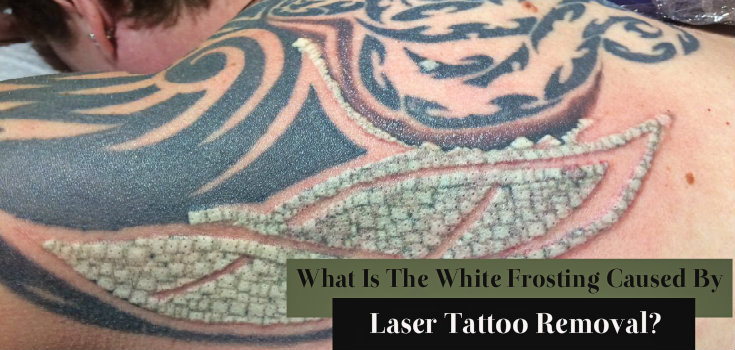-
30 August 2019
What Is The White Frosting Caused By Laser Tattoo Removal?

Tattoos have always been a much-loved body art form across the globe. However, their permanent nature and sometimes the frivolous attitude of the bearer can make people regret their presence on the skin. This is the reason why laser tattoo removal in Melbourne has become as popular as the inking process itself.
The treatment allows you to get rid of the unwanted ink without causing any damage to the skin. Since the technology is relatively new, many people are not aware of the effects and look of the skin during the treatment.
So when they come across a picture of a laser-treated tattoo covered in a white layer, they become perplexed and apprehensive about the procedure. The white frosting due to laser tattoo removal usually appears after the first session and is not a side-effect. Let us understand it in detail.
White frosting is the name given to the puffy white appearance after the laser targets the ink during the tattoo removal process. It is called frosting because it looks similar to a cake frosting, a white layer made from cream. T
he beam of the laser heats the pigment in the skin, which creates gas or plasma. This gas rises to the epidermis and is released from the skin in the form of carbon dioxide, which looks like a chalky layer on the tattoo.
It is not a harmful reaction, but the assurance that the laser is targeting the pigment and the skin is instinctively working upon healing itself. The white frosting is a result of the rapid healing of the treated area where the pigment is broken by the laser.
Thus it is a natural outcome and should not be considered as harmful or a negative impact of the treatment. In fact, it indicates that the laser was absorbed by the pigment and is working effectively.
It is a temporary effect of laser treatment and disappears within half an hour of its appearance. If you are undergoing the first session, then you are more likely to see the frosting. However, it becomes diminished with the subsequent sessions.
The reason behind this is that there is lesser ink to act upon after each session and thus lesser frosting. It is a positive sign shown by the body which signifies that the healing process has already started.
Also, it is not mandatory to witness frosting every time after the first procedure as different ink colours react differently to the laser.
In fact, some of the colours do not lead to frosting, and the reaction also depends on your skin type. So don’t get confused if you don’t see the frosting after your first laser tattoo removal session.
Besides the white frosting, which is absolutely a normal body reaction, the other side-effects include mild bruising, scabbing, soreness and inflammation. These are all indicators of the beginning of the healing process and should not be a cause of concern.
These usually go away in a few days, and if you follow the before and after-care instructions of the technicians carefully, you can easily avoid them or reduce them. However, to stay away from any skin damage, you must consult a qualified, licensed and experienced technician in Melbourne.
The treated area can look like a wound for 1-2 weeks, but you should not scratch or pick on the scabbing skin. The scabs can be moisturised using Bepanthen ointment, and you must visit your technician if you witness anything unusual.
You must stay away from the sun or apply sunscreen when going out. Also, you need to avoid rigorous physical activity for 24 hours after the sessions.
Laser technology has successfully been used to remove tattoos, fade the ink, or make customised modifications to the art. The medical-grade Fotona QX MAX laser system comprises four wavelengths, which attract different ink colours and remove them completely.
It is safe to be used on all skin types and breaks the pigment into smaller particles, which are eliminated by the immune system naturally. The Q-switched laser ensures that a minimum amount of heat is transferred to the skin to avoid any damage.
It provides permanent removal of ink and brings the skin back to its original state. The non-invasive procedure does not cause much pain and can be completed in a few sessions depending upon the size of the tattoo and the colours used in it.
The white frosting is part of the healing process, and there is no need to be worried about it. So when you are undergoing laser tattoo removal in Melbourne, it is recommended to follow the guidelines offered by the technician to ensure that you do not hamper the healing process.